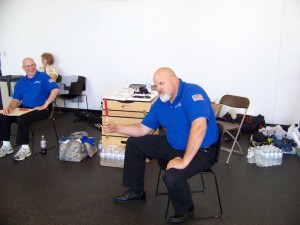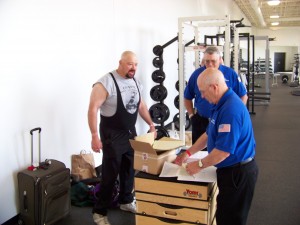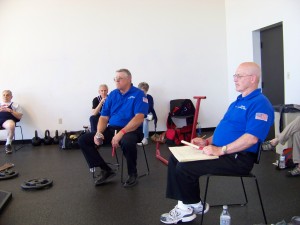Ravenswood Formula

Thom Van Vleck flashes the "Red Light" at USAWA Heavy Lift Nationals as Head Judge Denny Habecker looks for the call. USAWA officials have a lot more to do than judging the lifts. There's a lot of math involved as well!
by Thom Van Vleck
I know we’ve probably overdone the talk on formulas to rate lifting performances, but here’s one more. I got a copy of Peary Radar’s Lifting News (Sept. 1965) and notice a story on page 20 titled “A New Simplified Formula for Accurate Rating of Lifting Performances”. This formula was being touted as an easy way to determine the best lifter. Evidently, before calculators, the “long hand” or “slide rule” multiplication using the “Hoffman Formula” often resulted on errors and hard feelings when the errors were revealed later. As a result, the Ravenswood Formula was developed.
I’ll stop right here and say I’m not pushing this to be used by the USAWA nor do I know if it favors heavier lifters (which I’m not sure why anyone would think I would want that….well…maybe I would “like” that). This is just an interesting piece of lifting history from a time when formulas in lifting seemed to be quite the hot topic.
The Ravenswood Formula sought to remove the error prone difficulty of multiplication and replace it with the simplicity of adding two numbers together. You were give two tables which are quite lengthy. Table “A” had a bodyweight coefficient which went from 110lbs to 370lbs and Table “B” had a “Total” or lift poundage coefficient which went from 105lbs to 2550lbs. You simply took the lifters weight and found the corresponding coefficient in Table A (a 4 digit number) and added it to the corresponding weight lifted/coefficient in table B (again, a 4 digit number). The theory being that this formula was much more simple and less prone to a mathematical error. You have to take the developer’s word that it’s “fair” or should I say “Accurate” as he does in the title. The developer was Stanley Gorajczyk. Not sure where “Ravenswood” came from….maybe easier to pronounce that “Gorajczyk”! Stanley was an Olympic lifter who got 5th in the 1967 Senior Nationals, so he was a pretty decent lifter as well.

Al Myers looks like he's trying to talk Head Judge Denny Habecker into a good call, but really Denny is busy "doing the math" and calculating the winner using the formula!
I just found it another interesting part of lifting history and went with earlier articles on this website that discussed weightlifting formulas. If you are interested in the tables let me know. It might be interesting to compare the outcomes of this formula to others!
